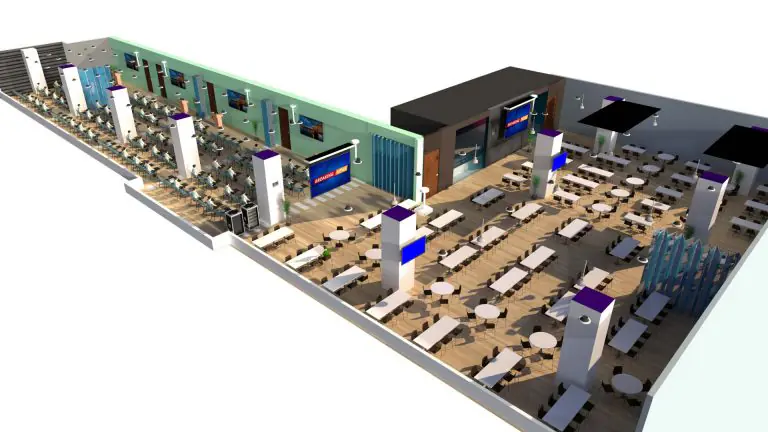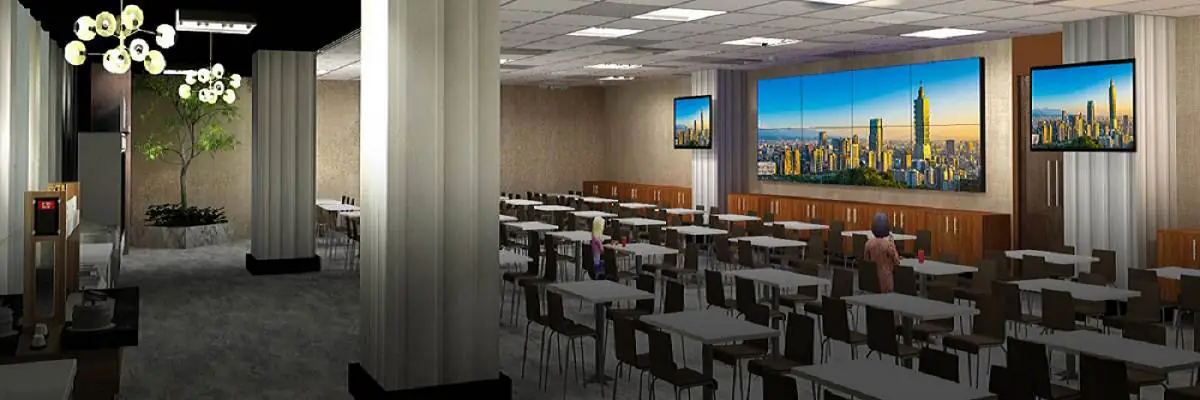Learn how to design hybrid-ready, reliable systems and elevate your town hall to broadcast-quality experiences with certified UC ecosystems, multi-camera PTZ, DSP-tuned audio and tack-sharp visuals.
Town halls in 2025 aren’t just big meetings, they’re brand moments, culture drivers and leadership broadcasts that must feel equally premium for in-room and remote participants.
Expectations now include near-broadcast production quality, reliable hybrid participation and measurable engagement, all delivered with tools that are simpler to operate and easier to scale than they were even a few years ago.
This modernised guide revisits our original article from 4 years ago for today’s realities: cloud-native platforms with certified ecosystems, AI-assisted production, redundancy-minded design and post-event analytics baked in.
Modern Town Hall Formats and What’s New in 2025
In-room town halls
Large AV systems now prioritise LED or high-brightness laser projection, speech reinforcement tuned by a DSP and multi-camera PTZ coverage, with simple, operator-friendly control surfaces and preset workflows to reduce risk.

Virtual Town Hall
Presenter kits have matured into compact “executive studio” bundles that include eye-level cameras, teleprompters, balanced 400–600 lux key lighting and discreet in-ear return, so leaders present naturally without tech distractions.

Hybrid Town Hall
The default for distributed teams, hybrid now leans on platform-certified devices, centralised control rooms (physical or virtual) and pre-event tech checks for remote guests to ensure smooth handoffs and consistent production value.
Core Technology Requirements: What Has Evolved
In-room production stack
- Visuals: Active LED for bright spaces or high-brightness laser projection, where modularity or budget demands it; confidence monitors for presenters and stage managers for real-time cues.
- Audio: Presenter lavs plus handhelds for Q&A, ceiling or beamforming mics for distributed pickup and a DSP matrix to separate in-room PA and far-end mixes to prevent echo and maintain intelligibility.
- Cameras and lighting: 2–4 PTZ cameras with presets (wide, podium, audience Q&A, panel), optional auto-tracking for single-presenter segments and stage wash lighting to keep faces well-exposed for remote audiences.
- Control and reliability: Redundant signal paths, dual network uplinks where feasible and role-based touch control ensure that operators, presenters and facilities each have the right level of access during live events.
- Interactive tools: Remote attention is fragile. Without intentional interactivity, participants drift and key messages are missed. Layer engagement natively into the run-of-show with live polls at transition points. Other interactive elements may include podiums with pens and touch displays, moderated Q&A with upvoting, short quizzes and chat prompts tied to each agenda segment. This creates frequent “touchbacks” that reset focus and improve recall. Use tools that embed into slides or your UC platform to avoid context switching and open pre-event question collection to surface the most relevant topics before the session begins. For large audiences, prefer platforms with frictionless access (links/QR, no app downloads) to maximise participation rates across devices and networks.
- Flexible attendance: Make every town hall accessible and on-demand by default, enabling cloud recording with transcripts, so anyone who misses the live event can catch up asynchronously and search for key moments later. Prioritise inclusivity with live captions, multi-language translation, screen reader compatibility and keyboard navigation. For equitable participation, combine in-room mics with moderated digital Q&A so remote attendees can be heard alongside those on-site.
- Quality-of-life enhancements: Adopt platforms that automate “busywork” and harden security, such as AI-generated notes, summaries and action items, real-time translations, watermarking and end-to-end encryption to protect sensitive leadership updates. Standardise IT-managed meeting templates, role-based controls and branded invitations/join pages for consistent, on-brand experiences at scale. Elevate production value with custom backgrounds, corporate colours and “together mode” scenes, while ops teams monitor real-time meeting telemetry for proactive troubleshooting and capture post-event analytics to guide future agendas.
Virtual presenter kits
A laptop still works, but adding a quality USB/NDI camera, proper key/fill lighting and a broadcast-quality mic dramatically elevates trust and engagement.
Hybrid orchestration
Certified ecosystems reduce last-minute compatibility issues and enable one-touch join in large rooms; a centralised control desk manages source switching, remote speaker greenrooms, content playout and Q&A to keep complex agendas on time.
Why Town Halls Need More Than a Standard Meeting Room

Town halls are closer to a live show than a meeting: expect more sources (multiple cameras, remote guests, content feeds), more destinations (in-room screens, far-end attendees, overflow streams) and higher stakes (executive messages, company-wide Q&A).
- For virtual-only, multiple PTZ cameras with a camera switcher can work for speed. Pairing it with production discipline (lighting, mic technique, shot framing) avoids “webcam fatigue.”
- For all-hands spaces, systems like Crestron’s Automate VX 1 can enable visual AI-assisted speaker tracking to deliver broadcast-quality and automated multi-camera cuts centred on the active speaker. DSP-managed audio and either LED or laser projection create the broadcast feel employees now expect across offices and time zones.
Cloud UC vs. Traditional Hardware VC in 2025
Cloud platforms have matured with built-in streaming/recording, scale-on-demand and frequent feature upgrades, while hardware VC remains useful for deterministic performance and “always-on” dialling in mission-critical rooms.
| Area | Trad. hardware VC codec | Cloud/Soft VC |
| Ownership Costs | Higher capex/opex for endpoints and infrastructure | Lower capex; opex scales with usage and licenses |
| Bandwidth | Predictable, often higher utilisation | Optimised usage with adaptive codecs |
| Infrastructure | On-prem, harder to scale quickly | Cloud-managed, elastic capacity |
| Cross device performance | Consistent across certified endpoints | Can vary on older devices; best with certified rooms |
| Streaming/recording | Typically extra hardware | Built-in cloud recording/VOD |
| Features/upgrades | Periodic, often paid | Frequent software updates |
| Ease of use | Auto dial/answer, appliance-like | One-touch join with certified room kits |
| Content sharing | Simple in a shared room scenario | Smoothest when each presenter joins to share |
It’s worth noting that traditional hardware VC is still used in government projects and banks where a dedicated SIP line is needed for hard VC dialling. High-end encryption is built into these solutions and they ensure compliance with HIPAA and FIRPA regulations.
Design Principles for 2025 Town Halls
- Standardise on certified ecosystems: Select devices certified for the chosen UC platform to reduce integration friction and enable one-touch start across rooms.
- Engineer audio first: Prioritise mic strategy, coverage, gain structure and mix-minus for remote sends as audio failures remain the fastest way to lose trust in an event.
- Build for redundancy: Dual encoders or backup paths for the outgoing program feed, alternate mics and a secondary network route pay for themselves the moment something fails.
- Centralise production: Whether a dedicated booth or a virtual control layer, single-pane-of-glass management for cameras, content and remote guests stabilises complex shows.
- Plan content like a broadcast: A tight run-of-show, lower-thirds or on-screen identifiers and pre-built video rolls reduce dead air and increase clarity for remote viewers.
- Analyse storage space requirements: 4K video typically requires at least 1TB of fast storage to ensure memory constraints don’t become a bottleneck for production. These requirements are slightly lower if only utilising 1080p resolution.
Case Snapshot: Ahmedabad University Multipurpose Sports & Event Hall
We delivered a multipurpose hall that transforms an indoor basketball court into a flexible event venue using automated retractable bleachers, integrated AV, stage lighting and high-impact visual systems.
- Transforming the space: Automated telescopic bleachers convert the court into a high-capacity event venue, enabling rapid changeovers between sports, assemblies and performances.
- Visual system: High-brightness laser projection provides large-format visuals suitable for ceremonies, talks and cultural events, with sightlines planned around bleachers and court geometry.
- Integrated AV and stage lighting: Multi-camera coverage, tuned audio reinforcement and stage lighting deliver clear sight and sound for audiences while supporting broadcast-quality capture for streams or overflow rooms.
- Operational agility: The system design prioritises fast mode changes, safe movement of seating and simple, operator-friendly control, so university teams can switch from sport to show with minimal downtime.
The result was a space that could convert into a high-capacity venue with automated retractable seating. Implementations typically sit in the 600–1,000 seat range depending on floor plan, safety aisles and production layout.
2025 Best-Practice Checklist
- Define the production standard: Decide whether the goal is “enhanced meeting” or “broadcast-lite” and scale camera, lighting and crew expectations accordingly.
- Lock the AV scene list: Pre-program camera presets and lighting scenes (keynote, panel, Q&A, wide) to reduce operator load and accelerate transitions.
- Greenroom remote speakers: In addition to acoustical treatment to eliminate audio feedback, run connectivity, audio and framing checks 30–60 minutes pre-show; hand them off to production only when cleared.
- Separate mixes: Provide distinct in-room PA and far-end program mixes via DSP to keep both audiences comfortable and echo-free.
- Capture and repurpose: Use cloud recording and VOD features to share highlights and measure engagement post-event; plan lower-thirds and chapter markers during the run-of-show.
The Bottom Line
A 2025-ready town hall blends broadcast thinking with collaboration platforms: certified ecosystems for reliability, AI-assisted and operator-friendly workflows and redundancy that keeps leadership messages on track, even when something unexpected happens. For large, flexible venues, design for fast mode changes, production-grade AV and clean hybrid participation from day one.
FAQ’s
Use a compact executive studio kit: a proper camera at eye level, 400–600lux lighting, a quality mic and an in-ear return for clean talkback.
Run remote greenrooms, verify audio/video/share permissions in advance and bring them live through a centralised control layer; certified room devices enable reliable one-touch join on site.
Yes, for mission-critical rooms, hardware provides deterministic performance and always-on dialling as a fallback; most organisations pair cloud-first workflows with limited hardware redundancy.
- COB (Chip-on-Board) LED walls deliver higher durability, better viewing angles, seamless surfaces and better contrast with reduced pixel gaps compared to SMD LED walls in bright, flexible spaces and as persistent signage; high-brightness laser projection remains cost-effective for very large images and multipurpose venues when ambient light can be managed.
Audio intelligibility and echo; solve with the right mics, loudspeaker zoning, DSP mix-minus and operator presets, plus backups for key signal paths.


